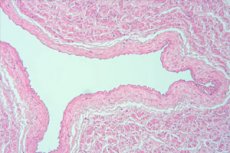
根据《临床研究杂志》发表的一项研究,西北医学院的科学家发现了一种再生小鼠受损心肌细胞的方法,这可能为治疗儿童先天性心脏缺陷和成人心脏病发作后的心脏损伤开辟一条新途径。
据芝加哥安和罗伯特·H·卢里儿童医院介绍,左心发育不全综合征(HLHS)是一种罕见的先天性心脏缺陷,是指胎儿在怀孕期间心脏左侧发育不正常。每5000名新生儿中就有1人患有这种疾病,占出生后第一周内心脏病死亡病例的23%。
新生儿科儿科教授、该研究的资深作者保罗·舒梅克博士说,心肌细胞是负责收缩心肌的细胞,可以在新生哺乳动物中再生,但随着年龄的增长会失去这种能力。
“出生时,心肌细胞仍然可以进行有丝分裂,”舒梅克说。“例如,如果一只新生小鼠的心脏在一两天大的时候受伤,然后等到小鼠成年后,当你观察心脏受伤的区域时,你永远不会知道那里曾经受伤。”
在当前的研究中,舒梅克和他的同事试图了解成年哺乳动物的心肌细胞是否可以恢复到胎儿的再生状态。
由于胎儿心肌细胞依靠葡萄糖生存,而不是通过线粒体产生细胞能量,Shumaker 及其同事删除了成年小鼠心脏中的线粒体相关基因 UQCRFS1,导致它们恢复到类似胎儿的状态。
在心脏组织受损的成年小鼠中,研究人员观察到,在UQCRFS1受到抑制后,心脏细胞开始再生。研究表明,这些细胞也开始消耗更多的葡萄糖,类似于胎儿心脏细胞的功能。
舒梅克说,这项研究的结果表明,增加葡萄糖的消耗也能恢复成年心脏细胞的分裂和生长,并可能为治疗受损心脏细胞提供新的途径。
“这是解决心脏病学最重要问题之一的第一步:我们如何让心脏细胞再次分裂,以便修复心脏?”舒梅克说,他也是细胞和发育生物学教授以及肺和重症监护科医学教授。
基于这一发现,舒梅克和他的同事将专注于寻找无需基因改造就能在心脏细胞中触发这种反应的药物。
“如果我们能找到一种药物,像基因改造一样激活这种反应,那么一旦心脏细胞生长成熟,我们就可以在药物的作用下停药,”舒梅克说。“对于患有HLHS的儿童来说,这可能有助于我们恢复正常的左心室壁厚度。这将挽救生命。”
舒梅克说,这种方法也可以用于治疗心脏病发作的成年人。
“这是一个大项目,我感谢所有参与的人,”舒梅克说。“这篇论文列出了15位西北大学的教职员工作为共同作者,所以这确实是一次团队合作。”

